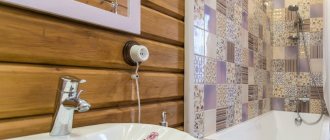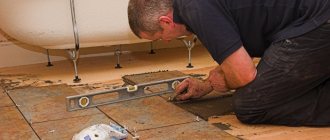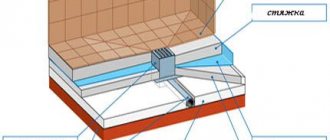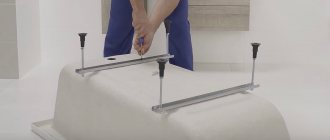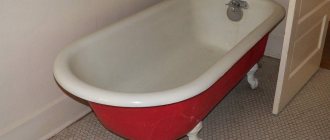Repairing, remodeling or arranging a bathroom from scratch always requires work with utilities. We can talk about dismantling old pipelines and then installing new ones, or just laying out the system, but in any case, the installation of pipes in the bathroom must be done competently and efficiently.
You can entrust this work to professionals who can easily cope with this task. However, if desired, a home master can carry out the wiring himself, which will allow him to save money on paying for plumbers’ services. How to perform all operations correctly? We'll figure out.
Design
Without a project, laying pipes will be more expensive, will take more time, and is fraught with errors during the work. The project must take into account the following factors:
- interior space layout;
- number of plumbing fixtures;
- pipe layout diagram;
- the amount of plumbing equipment on the cold water/hot water supply lines;
- presence, location of a water heater, heated towel rail, water heated floor;
- pipe material, method of connecting them;
- design, quality of bathroom interior.
In apartments of standard multi-storey buildings, there are several options for planning bathrooms:
- combined near the kitchen;
Communication diagram with one riser for the kitchen and bathroom. - combined separately from the kitchen;
Combined bathroom with independent riser. - separate near the kitchen;
Separate bathroom with common riser. - separate from the kitchen.
In a separate bathroom, the risers usually run inside the toilet and enter the bathroom through the wall.
In the first and third cases, the pipes are changed in the bathroom, toilet, and kitchen. In the fourth option, cold water/hot water supply risers and sewers usually run in the toilet, and only from there do communications enter the bathroom. The second option is the most convenient for major repairs - all the risers are inside the combined bathroom.
In a combined bathroom, all pipes are collected inside one room.
Then you need to take into account the number of plumbing fixtures indoors:
- bathroom – washbasin, bath and/or shower, washing machine;
- combined bathroom - a toilet and bidet are added to the above.
More plumbing fixtures fit inside the combined bathroom.
In addition, an instantaneous or storage water heater can be placed in the bathroom, and water heated floor contours are often laid under the floor covering.
The heated towel rail in the bathroom serves as room heating. This device can be connected to a central heating system with a separate riser, or to a hot water supply system.
Even in a small room, there can be a washing machine under the sink inside the bathroom.
Attention: Some electrical appliances (bidet or toilet lid, lighting, shower stall) require an additional cable. Others (water heater, washing machine) have an outlet.
Read more: Basics of proper bathroom wiring.
Why develop a wiring diagram?
Such a scheme is necessary to obtain a high-quality result. With its help, you can accurately calculate the number of bends and connections, determine areas for connecting equipment and significantly save materials and time.
The following mandatory elements must be included in the wiring diagram:
- shut-off and control valves;
- water meters;
- filters;
- fittings (adapters, water sockets, angles and couplings)
- check and pressure reducing valves;
- sewer;
- connection to the heated towel rail.
In order for the wiring diagram to be accurate, you need to clearly understand the installation location and the number of required plumbing fixtures
We begin the development of the scheme by drawing up an accurate floor plan. On it, in the appropriate scale, we indicate the location of all plumbing fixtures, furniture and household appliances. We carefully consider the arrangement so that there is enough space left for free use of the equipment.
Doors should also open freely. The diagram shows the dimensions of all elements, this will make it easier to calculate the number of pipes needed to create utilities.
An important point: if the bathroom and toilet are separate, we carry out the wiring in them simultaneously, since these rooms will be connected to a single system.
After we have decided on the quantity and location of plumbing equipment, we begin planning the wiring. To do this, we draw on our diagram the location of the water supply and sewer pipes. During the planning process, we try to adhere to the following rules:
- Pipes must not intersect. This is only possible when it is not possible to do the wiring differently.
- There must be free access to areas for connecting plumbing equipment and metering devices.
- It is advisable to place sewer and water pipes close to each other. In this case, they can later be easily closed with a common box.
- The number of connections must be minimized.
- Connecting couplings and pipes must be homogeneous, that is, made of the same material.
- If possible, pipelines should be thermally insulated so that condensation does not settle on them.
Experts advise not to complicate the wiring and keep it extremely simple. It is optimal to lay all main pipes below, above the floor. From them, water outlets should be installed perpendicularly upward through the tees.
When laying sewer outlets, you need to keep in mind that they may not have a vertical part. Such a part will be a standard sewer tee into which a flexible hose is directed.
After we have marked on the diagram all the pipelines and sections of their connections, we can calculate the length of the elements necessary for arranging the wiring and the number of additional parts.
Closed installation requires labor-intensive preparation. The walls are grooved for pipes and connecting elements. Be careful: it is prohibited to tap load-bearing walls
Plumbing
There are two standard wiring diagrams for cold water/hot water supply systems in an apartment and a country house:
- sequential - one cold water pipe, one hot water pipe is stretched from the riser to the farthest consumer, all plumbing fixtures are connected to it with tees, the latter with a tap;
Sequential circuit. - collector (parallel) - installation of cold water and hot water pipes from the riser to each plumbing fixture separately.
Connecting consumers to the water supply through the collector.
The first option is more economical due to lower pipe consumption. Hiding the water supply in the wall is much easier, and the labor intensity of rough finishing is reduced. The disadvantage is that the entire line is disconnected when repairing any plumbing fixture inside it, since the shut-off valves are located immediately after the riser. And also great sensitivity to peak consumption, for example, you are taking a shower, and someone decided to wash the dishes in the kitchen, before going to the toilet, the pressure in the shower will drop significantly.
In the second option, immediately after the meter, a collector is mounted on the cold water line, similar to a “comb” fitting on the hot water line. The two lower pipes go to the farthest mixer or device, the next two pipes are mounted on the walls above the previous ones, and so on until the consumer closest to the riser. This will avoid crossing communication routes with each other.
The advantage of the scheme is to turn off one device as needed while maintaining water supply to the others. Less sensitive to peak demand. The disadvantages are the increased consumption of materials, increased labor intensity of hidden wiring, and the cumbersome nature of the collector water supply system.
In apartments with gas instantaneous water heaters (“boiler” in popular parlance), a sequential wiring diagram is usually used. There is no particular point here in the DHW collector, since in this case it will not be possible to get rid of sensitivity to peak water consumption, because all the hot water will pass through a narrow pipe (usually 15 mm) inside the column or double-circuit boiler.
Each water supply line uses the following number of plumbing fixtures, starting from the riser:
- non-return valve – prevents self-priming from the adjacent line in the event of an emergency shutdown of water supply;
Check Valve. - shut-off valves - usually a lever-type ball valve with a long service life;
Ball valve - leakage protection valve – automatically shuts off the line in emergency situations;
Such a valve requires water leakage sensors, a controller, and a network connection. - coarse filter (GO) – filters out mechanical impurities;
Coarse water filter. - water flow meter - installed according to the requirements of the cold water/hot water supply supplier;
Water meter. - fine filter – increases the service life of mixers;
Fine filter. - pressure reducer – relevant for apartments with pressure above 4 bar;
Pressure reducer. - collector - the number of pipes depends on the number of consumers in the apartment.
Collector.
From this list, 4 devices are considered mandatory - a tap, a meter, a GO filter and a check valve. All this equipment is mounted near the riser and takes up a lot of space. An inspection hatch is installed to provide access to metering devices, shut-off valves and other devices.
To reduce the dimensions of the circuit, some of these devices can be built into each other. For example, a reducer with a check valve, a GO filter with a reducer, and so on.
The technology for laying out cold/hot water supply lines for an apartment step by step looks like this:
- dismantling the existing wiring - pipes are removed up to the shut-off valves on the risers;
- marking - it is recommended to use laser plane builders and levels;
Marking cavities for laying pipes. - gating – angle grinder channels are cut in the enclosing structures, structural material is knocked out to form cavities, taking into account the laid routes;
Grooves on the walls for laying pipes. - installation of water sockets - fittings are attached to special strips, which are, in turn, installed on dowel nails;
Installation of water sockets. - assembly of water supply loops - in the above sequence, the meter, filters, manifold, reducer, check valve are twisted together (which thread seal to use);
Counter assembly. - system assembly - the circuits twisted at the previous stage are mounted at the place of operation;
- pipe preparation - pieces of the designed length are cut from the coil, thermal insulation is put on them;
- installation of pipes - one edge is connected to the collector, every 0.5 m is fixed to the wall with special holders, the second edge is connected to the water outlets.
Pipe installation.
Attention: The standard connection of water pipes to the outlet is considered to be cold water on the right, hot water on the left.
Before sealing the pipeline inside wall cavities and partitions, it is necessary to perform pressure testing of cold water/hot water supply systems. To do this, plugs are screwed onto the sockets and pressure is applied to the pipes for 15 - 30 minutes.
Temporary plug for water sockets.
Pipes can only leak if there is mechanical damage to the structural material. Therefore, during crimping, only the connection points with the fittings are checked - at the point of connection to the manifold and socket, plus all the threads in the upper loop between plumbing fixtures.
Preparatory stage
Many people are interested in the question of how to properly make a sewer? It is worth paying increased attention to the preparatory stage. If you neglect this stage and do not prepare the necessary tools, then laying out pipes in the bathroom and installing the sewer system will take quite a lot of time.
The preparatory stage consists of important rules:
- First you need to decide on the devices and their location. You can draw a diagram on a blank sheet of paper. Be sure to consider what fittings and additional pipes will be needed for the full operation of the sewage system;
- if suddenly there is an installation of some additional device, the working process of which will require a sewer drain, then it is better to provide a closable type outlet with an additional plug;
- Once all the dimensions have been calculated, the products can be cut. Be sure to consider the fitting parameters;
- many experts advise cutting the pipes before starting installation, because they can be easily tried on when assembling the networks;
- It is better to cut plastic pipes with a hacksaw for metal products;
- To easily cut the pipe, it can be outlined in a circle in the desired area. The cut will be even and tight;
- products are cut only at right angles;
- cut edges of products are cleaned with sandpaper or a knife;
- Be sure to remember that replacing a sewer pipe in an apartment should be done on a slope, because the working process of almost any sewer system occurs under the influence of “gravity.” The tilt of the products is fixed using brackets that are attached to the wall.
Special tool for manual pipe cutting
The workflow will require the following equipment:
- grinder or hacksaw for cutting metal materials;
- impact drill or hammer drill;
- mounting gun;
- chisel;
- screwdriver;
- hammer;
- adjustable wrench.
Required Tools
Sewage installation
Do-it-yourself sewer installation is much easier than installing water lines. The main nuances of the internal drainage system are:
- slope to the riser 2 cm vertically per 1 m length;
- the use of gray socket pipes for internal sewerage;
- direction of the sockets from the riser;
- pipe diameter 110 mm for the toilet, 50 mm for horizontal lines, vertical sections;
- the use of oblique tees with a 45° upper branch pipe in the middle of the main line, a 90° branch for connecting the plumbing fixture farthest from the riser;
- use of 45° bends to bend the sewer at one horizontal level.
Sewer pipes are laid from the riser cross towards the toilet, sink and other plumbing fixtures in stages:
- installation of a 110 mm section to the toilet;
- installation of a tee with a transition to a diameter of 50 mm;
Transition of the drainage system from a diameter of 110 mm to 50 mm. - distribution of the utility system along the wall to the farthest consumer.
Depending on the location of the riser, household and plumbing fixtures, and the layout of the bathroom, the pipes can go in one direction or diverge in different directions. This changes the type of fittings and their number for assembling horizontal lines.
The electrical cable is embedded in the wall higher than the water supply and drainage system. This reduces the likelihood of a short circuit due to a break in the sewer system or cold water/hot water pipes.
By analogy with water sockets, the sockets of sewer pipes and fittings can be embedded in walls. All plumbing drains are connected to tees, bends through pipes, corrugations with a diameter of 40 mm only after siphons with hydraulic seals.
The exceptions are toilets, urinals, and bidets, in the bodies of which siphons are structurally built-in.
To prevent sewer odor, corrugated or rigid pipes are connected to the fittings of the internal sewerage system through rubber cuffs with a “ruff”.
Purchasing the necessary material and tools
According to the requirements of building codes and regulations, the following types of pipes are allowed to be used for sewerage installations:
- cast iron;
- ceramic;
- asbestos-cement;
- ceramic;
- polyethylene, polypropylene, PVC or plastic.
Sewer pipes
Today, in practice, pipes made of polyethylene are most often used (GOST 22689.0-89 and GOST 22689.2-89). The regulated diameter of sewer pipes is 40, 50, 90 and 110 mm; polypropylene pipes, as a rule, have a diameter of 32, 40, 50 or 100 mm. Made from polymer pipes, the DIY bathroom drainage system has excellent resistance to both aggressive environments and corrosion.
Heated towel rail
A mandatory attribute inside the bathroom is a heated towel rail. In standard apartment buildings, a separate heating riser is usually installed for this plumbing product. This is the most difficult pipe installation option for a number of reasons:
- the riser comes out of the lower ceiling and enters the upper slab;
- for hidden wiring, you will either have to make a false panel from plasterboard, or chisel reinforced concrete slabs to mount bends and cut grooves in the walls.
Less often, the specified device crashes into the hot water supply system, then there is no problem with hidden pipes to water outlets.
There are electric modifications of the heated towel rail that work even when the heating of the house is turned off. They are installed after laying the tiles, and an electrical outlet is installed for connection.
Dismantling old communications
Before changing the pipes in the bathroom, it is necessary to completely dismantle the old communications. Often this operation takes more time, effort and nerves than directly laying new pipes. To remove old plumbing and sewer, you need to take the following steps:
- You must submit an application for work to the management company that services your home. They must give the owl consent and possibly send a technician to shut off the water supply and perform technical supervision.
Pipe dismantling - You need to notify your neighbors whose apartments are located along the same riser in advance that you are going to carry out repair work and shut off the water supply. At this stage, you should determine a connection that is convenient for most times.
- Before you begin replacing the pipeline in your apartment, you must reliably shut off the supply of cold and hot water through the riser, and only then begin work.
- After finishing the work, it is important to restore the water supply before the agreed time so as not to displease the neighbors.
Remember! If you are going to change not only the pipes that run exclusively through your apartment, but also the riser, you must completely shut off the water supply in the basement of the house; this also requires the consent of the management company. In addition, the riser needs to be changed from the apartments of the neighbors below and above, so you will also have to agree with them in advance.
Water heated floor
It is possible to connect the circuits of a water heated floor to the central heating line only in one case - if the apartment has only one riser for this purpose, from which the supply and return lines are extended to all registers in the premises. In other options, for a warm water floor, either a separate boiler is installed, or a heat exchanger is used that heats the water using the thermal energy of the centralized heating system.
For TP circuits, a collector wiring diagram is always used. Pipes are installed before pouring the screed, only in walk-through areas of the bathroom. They have no effect under the bathtub, cabinets, shower stall, or washing machine.
Heat exchanger for water TP.
Due to the bulkiness of collector units with heat exchangers, most users use electric-type heated floors (IR, heating cable, cassette modifications).
What materials should I use?
It is quite difficult to answer this question unequivocally - there are a lot of influencing factors. Let’s just say that the most popular among the consumer audience when creating sewer pipelines and cold water systems are polypropylene and PVC pipes. Where it is intended to transport hot water, it is worth giving preference to metal-plastic. A stainless steel heated towel rail will last longer than a brass one.
Hidden communications wiring
There are four ways to conceal communications in a bathroom:
- box - plasterboard or gypsum plasterboard sheet fixed to a profile frame, covering part of the supporting structure (walls, partitions) where the pipes pass;
Piping in the box. - false panel - the entire wall is covered with plasterboard, again, on a lathing made of galvanized profile; PVC panels on a frame made of bars are less commonly used;
Disguising utility networks with a false panel. - cavity in the wall - after marking the water supply and sewerage routes, you need to trench a concrete or brick wall, lay pipes inside the resulting channels, cover it all with putty;
Laying pipes in grooves. - laying in a screed - pipes are laid on the lower floor and filled with concrete, semi-dry screed.
Pipes for screed.
Comparative characteristics of these technologies are given in the table below:
| Characteristics | Hidden installation type | |||
| box | false panel | grooves | screed | |
| usable volume of the room | decreases slightly | decreases much | does not change | is decreasing |
| labor intensity of work | low | average | very high | high |
| interior quality | average | high | ||
| access to communications | through the inspection hatch | – | – | |
| compatibility with installations | + | – | ||
| presence of wet processes | – | + | ||
| turnkey delivery | 1 day | 2 days | 2 – 3 days | a week |
Boxes reduce the quality of interior design, but convenient niches and steps appear for placing accessories and storing bath accessories. Behind the false panels you can hide any number of pipes, a boiler and other equipment. But, to attach wall cabinets and shelves, you will have to install additional racks made of galvanized profiles.
Outdoor installation of engineering systems
In Soviet times, open wiring of engineering systems was considered the standard. Even to the bathtub faucet, the pipes approached from the outside of the wall cladding, forming an inconvenient, unsightly gap between the side of the bowl and the enclosing structure. This method makes it much easier to bypass intersecting water supply and sewer lines.
Currently, water outlets are used, that is, cold water/hot water supply pipes laid in grooves. With sewerage, everything is much more complicated due to the too large diameter of communications. Therefore, a combined method is used here:
- behind the bathtub the pipes are laid in an open manner;
- the risers are closed with boxes, inside which additional plumbing equipment is installed - a meter, a manifold, filters, a reducer, a valve, shut-off valves, a boiler;
Riser box. - hanging plumbing installations are covered with plasterboard sheets by default;
- For the washing machine, bidet, and toilet, single water sockets are installed for cold water only;
Water socket for washing machine. - Double water sockets are installed for the bathtub faucet, washbasin, and shower cabin;
Double water socket. - Sewer pipes for sinks are often installed hidden; for bathtubs and showers they are laid openly.
Hidden sewer installation.
To connect mixers with hot water/hot water outlets, flexible open wiring is used - hoses. The washing machine drain is connected to a special fitting on any tee of a plumbing fixture.
Methods for installing water pipes
To install plumbing pipes, you can choose one of two options: hidden and open. Let's look at the latter in more detail.
Method #1. Open gasket
Open installation assumes that pipes and other utility elements are mounted directly on the wall or above the floor. This makes their installation extremely easy and cheap. But the overall appearance of the bathroom suffers from this.
The advantages of open installation include:
- the possibility of continuous monitoring of the condition of utilities - pipes are always in sight and the appearance of a leak will not go unnoticed;
- ease of installation - the parts are connected and fixed in place, even a novice plumber can handle the job, taking into account, of course, the way the elements are connected.
- Availability – installation cost is minimal.
Disadvantages include the possibility of mechanical damage to open pipes. But this is more likely to be true for plastic parts. Steel pipes are not that easy to damage.
In addition, engineering communications are available for everyone to see, which, of course, is ugly. This disadvantage can be combated. When carrying out a wiring project, you should try to choose a place for laying pipes so that they are as inconspicuous as possible.
The method of open pipe laying is as simple as possible to implement. The result is a functional, but unsightly pipeline. Therefore, they try to make it as inconspicuous as possible.
It is clear that it will not be possible to completely disguise them in this way. Therefore, home craftsmen use all sorts of designs to hide unsightly pipes. The easiest way is to cover them in a box.
Most often it is made of plastic panels or plasterboard. The latter must be moisture resistant, given that it will be used in the bathroom.
If space allows, it is quite possible to use false walls behind which pipes are laid. A good option is roller shutters; they look especially good behind the toilet.
Image gallery
Photo from
Open water supply layout
Construction of a water pipeline from polymer pipes
Free access for inspection and maintenance
Distances between hot and cold lines
When choosing an option for masking communications, you need to understand that aesthetics should not interfere with functionality, therefore all masking structures must be equipped with hatches through which inspection and necessary repairs of pipes will be carried out.
In addition, some pipes are not recommended to be masked. These are, for example, parts made of steel. They are susceptible to corrosion, which develops especially quickly in conditions of high humidity. Therefore, they are best used only in open form.
The maximum is to close it with an easily removable box and regularly carry out inspections for the appearance of external corrosion, which must be dealt with immediately.
Method #2. Hidden installation of utilities
Laying out pipes in a hidden bathroom involves installing parts inside specially provided or newly created voids in building structures. These can be small niches or grooves hollowed out in the walls, whose dimensions are slightly larger than the diameter of the pipes being laid.
Hidden laying also includes laying the pipeline in a screed, when a layer of concrete mortar is mounted on top of the parts.
Sawing or cutting grooves for pipes is a very labor-intensive operation. Before performing them, you should draw lines on the wall where the grooves should go, and calculate the exact dimensions of the cavities for the pipes
The undoubted advantage of this option is aesthetics. Engineering connections and communications are completely invisible. Pipeline outlets in the form of sewer sockets or water outlets are placed on the walls or in the floor. Accidental damage to pipes is impossible.
Significant disadvantages of the method include:
- labor intensity;
- cost;
- lack of ability to control the condition of the pipeline.
Let's take a closer look at hidden installation. First of all, it is not always possible. Cutting or hollowing out grooves in walls is allowed in private houses built from solid blocks or bricks, as well as in open-plan apartments.
In the latter, walls of increased thickness are made. In all other cases, there may be conflicts with building codes.
Image gallery
Photo from
Laying the pipeline in grooves
Taking into account thermal expansion
Assembly of a polypropylene pipeline
Installation of metal-plastic water pipes
Load-bearing structures experience significant load. The grooves significantly weaken them. This is acceptable for walls of increased thickness. For standard ones, which are most often used in standard buildings, no.
Making grooves in floor slabs is strictly prohibited for all types of buildings. As an alternative to grooves, the pipeline can be laid behind the wall sheathing, in the screed or in the above-ceiling space, if necessary.
When carrying out hidden installation of pipes, it is imperative to provide for the possibility of free access to the collector and meters, and also, if possible, arrange inspection hatches
Difficulties may arise with the sewer pipeline if it needs to be disguised under the floor. This happens when, for example, you need to connect communications to an island bathtub located in the middle of the room or at a considerable distance from the wall. Sewer pipes have a large diameter, so they cannot be laid in a screed.
In this case, it will turn out to be too high and heavy, which will become too much of a load on the floors, which may simply not withstand it. The best solution is to build a small podium, under which there will be enough space for utilities. The design can be frame or block.
Regardless of the location where the pipeline is hidden and its purpose, the method of installing the parts does not change. All elements of the pipeline are laid in a special casing pipe, the latter is placed in a prepared technological cavity.
After the pipeline is laid, the cavities are sealed and the base plane is leveled. If necessary, a topcoat is applied.
The main disadvantage of hidden installation is the inability to control the condition of the pipeline. For this reason, all its elements must be as resistant to corrosion as possible and reliably connected. Proper installation is very important.
The best option for hidden installation are plastic, copper and metal-plastic pipes.
After laying the system in the prepared cavities, the grooves are carefully sealed with mortar. The plane is leveled as much as possible and prepared for subsequent finishing.
Another important point that must be taken into account when installing pipes hidden is to prevent possible condensation formation. If this happens, moisture will appear inside the structure, which will sooner or later cause its destruction.
Therefore, it is recommended to place the hot water pipe above the cold one. In addition, both parts should be wrapped in heat-insulating material, for example, Merylon or the like.
